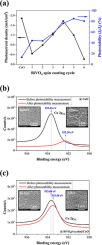Journal of Industrial and Engineering Chemistry ( IF 5.9 ) Pub Date : 2021-08-28 , DOI: 10.1016/j.jiec.2021.08.037 Hyunjin Jeong 1 , Hyukhyun Ryu 1 , Jong-Seong Bae 2

|
We fabricated BiVO4/CuO heterojunction photoelectrodes by depositing BiVO4 capping layers on CuO photoelectrodes and investigated the photocurrent density and photostability of the photoelectrodes according to the number of BiVO4 depositions using the spin coating method. The morphological, structural, optical, electrical and photoelectrochemical properties of the BiVO4/CuO photoelectrode were investigated using field-emission scanning electron microscopy, X-ray diffraction (XRD), X-ray photoelectron spectroscopy (XPS), UV–visible spectroscopy, electrochemical impedance spectroscopy, and three-electrode potentiostat/galvanostat equipment. XRD and XPS results showed that the crystallinities and binding energies of BiVO4/CuO photoelectrodes were affected by BiVO4 compared to the CuO photoelectrode. In particular, XPS measurements showed that the Cu 2p3/2 peak binding energies of the CuO photoelectrode and BiVO4/CuO photoelectrodes with poor photostabilities shifted to those of Cu2O, showing self-reduction from CuO to Cu2O, after photostability measurement. In contrast, BiVO4/CuO photoelectrodes with proper BiVO4 deposition cycles showed good photostabilities without self-reduction. The BiVO4/CuO photoelectrode with 4 BiVO4 deposition cycles showed a high photostability of 76.2% via photocorrosion suppression, which is a much improved result compared to the single CuO photoelectrode with a photostability of 13.1%. However, the photocurrent density of −1.77 mA/cm2 (vs. SCE at −0.55 V) is still low, and further study is necessary.
中文翻译:

通过防止 CuO 自我还原为 Cu2O,在 BiVO4 覆盖层的帮助下改善 CuO 光稳定性
我们通过在 CuO 光电极上沉积 BiVO 4覆盖层来制造 BiVO 4 /CuO 异质结光电极,并使用旋涂方法根据 BiVO 4沉积的数量研究光电极的光电流密度和光稳定性。形态中,BiVO的结构,光学,电学和光电化学性质4 / CuO的光电极使用场致发射扫描电子显微镜进行了研究,X射线衍射(XRD),X-射线光电子能谱(XPS),紫外可见光谱,电化学阻抗谱和三电极恒电位仪/恒电流仪设备。XRD 和 XPS 结果表明 BiVO 4的结晶度和结合能与CuO光电极相比,/CuO光电极受BiVO 4影响。特别是,XPS 测量表明,光稳定性差的 CuO 光电极和 BiVO 4 /CuO 光电极的 Cu 2p 3/2峰值结合能转移到 Cu 2 O 的结合能,表现出在光稳定性后从 CuO 自我还原为 Cu 2 O测量。相比之下,具有适当 BiVO 4沉积循环的BiVO 4 /CuO 光电极显示出良好的光稳定性而没有自还原。具有 4 BiVO 4的 BiVO 4 /CuO 光电极沉积循环通过光腐蚀抑制显示出 76.2% 的高光稳定性,与光稳定性为 13.1% 的单个 CuO 光电极相比,这是一个大大改善的结果。然而,-1.77 mA/cm 2 (vs. SCE at -0.55 V)的光电流密度仍然很低,需要进一步研究。











































 京公网安备 11010802027423号
京公网安备 11010802027423号